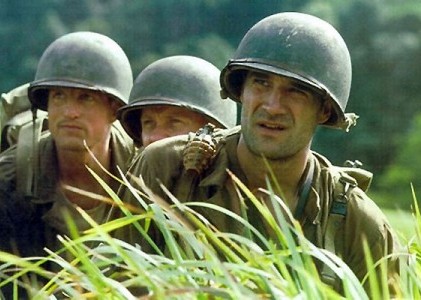Terrence Malick’s “The Thin Red Line” is one of the most beautiful war films ever made. Whereas most directors making an anti-war film would photograph in dim light and with a chaotic queasy cam, “The Thin Red Line” is a lush, colorful, sweeping film from start to finish. When it is not in the midst of a battle, it finds more than enough times to be quiet, elegiac, and although it sounds like an oxymoron in a war film, peaceful.
A World War II epic released in 1998, I watched it in preparation for Malick’s upcoming “The Tree of Life,” and it is a stunning, modern, timeless film of relentless emotion and vivid cinematography. Few other war films have a moving, soaring camera during action sequences the way “The Thin Red Line” does, and Malick’s graceful jib shots made for an eye-opening war experience unlike any I had seen on film.
And yet some of the film’s most memorable shots seem very nearly out of place. One of the best is a quick glimpse of a mangled bird struggling to inch its way out of a tree. Malick populates his entire film with rich natural imagery. Nearly all of the battle sequences take place on a verdant hill with tall grasses that were reminiscent of the glorious wheat fields in “Days of Heaven.” And his whole reason for calling our attention to the wonderful looking things around this desolate war zone is to draw the dichotomy between hopeful beauty and pitiful bleakness.
The cast is star studded with past, present and future Oscar winners. Here is just a short list of names you will no doubt recognize: Sean Penn, Nick Nolte, James Caviezel, Elias Koteas, John Cusack, Adrien Brody, John C. Reilly, Woody Harrelson, Jared Leto, John Travolta and George Clooney (who is literally in one scene about 150 minutes into this 170 minute epic, but you can’t miss him).
All of them give wonderful performances, and yet all were forgotten that year at the Oscars, despite the fact the film was nominated for seven awards. It lost all of its honors, including the much deserving Best Picture, Best Director, Best Cinematography by John Toll and Best Score by Hans Zimmer to “Shakespeare in Love” and “Saving Private Ryan” (although “Life is Beautiful” took Best Score).
It’s regrettable, because”The Thin Red Line” has yet to be included in the canon of great war films, and ironically Steven Spielberg’s other World War II epic from the same year certainly is. Malick’s film is at least as good, if not better than “Saving Private Ryan.”
I’m looking forward to seeing “The New World” and “Badlands” to finish out all five of Malick’s films.
